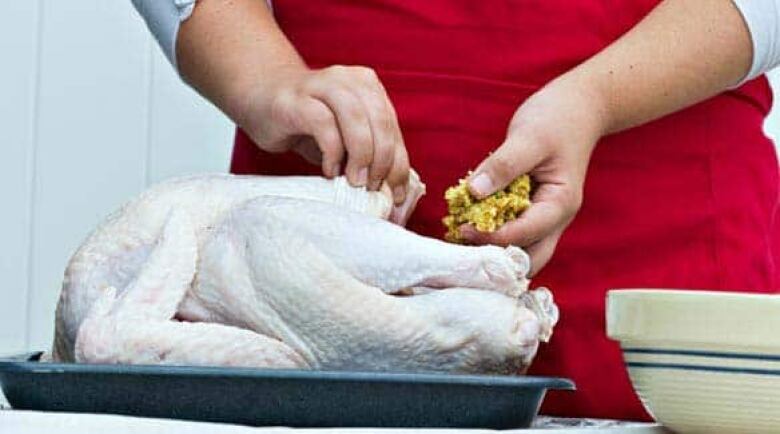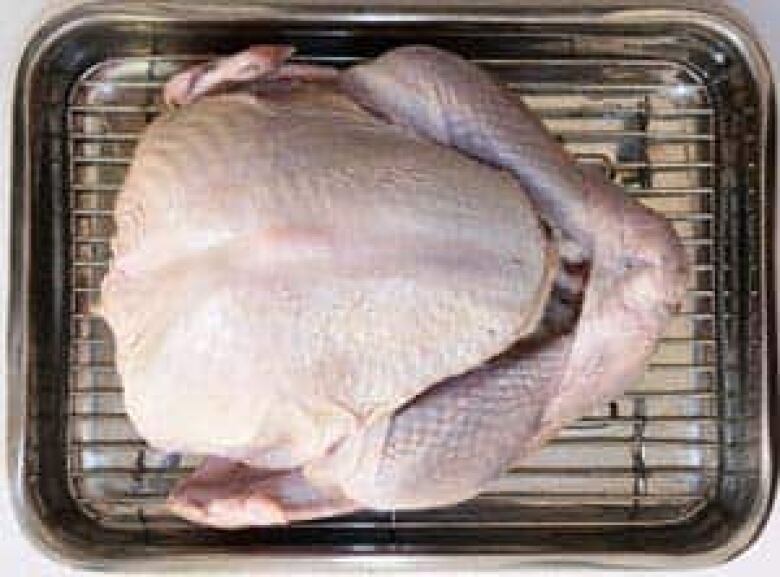A few precautions can make the difference

Thanksgiving is the No. 2 turkey-consumption time in Canada, when nearly three million of the fowl are sold, according to the Turkey Farmers of Canada.(Peak season is Christmas, when Canadiansbought4.5 million whole turkeys in 2009, or43 per cent of all whole turkeys sold in the country for the entire year.)
Canadian turkey consumption has remained fairly stable over the past 20 years at around 2.4 kilograms per person per year, according to Statistics Canada, whichcalculates based on the weight of the meat but not bones. Turkey production has been on an upward spiral, though, as more birds are shipped out of the country.
Canada produces more turkeys than it consumes but still importsa small quantity, mainly from the United States.
Here are some tips on how to make sure your holiday feast doesn't wind up cramping your style or your digestive system.
Buying a fresh turkey
| Top 10 turkey-producing countries 2006 production (tonnes) | |
| United States | 3,259,700 |
| France | 501,127 |
| Germany | 375,996 |
| Italy | 273,816 |
| Brazil | 215,190 |
| United Kingdom | 206,031 |
| Canada | 163,411 |
| Hungary | 108,018 |
| Israel | 105,000 |
| Chile | 90,399 |
Source: Statistics Canada
Whether at the supermarket or your local butcher shop, there are steps you can take to reduce your risk of contracting a food-borne illness:
- Check the "best before" date to make sure you have the freshest turkey.
- Purchase it no more than two days before cooking.
- The turkey should be cold when bought and immediately refrigerated at home at a temperature of 4 C (39 F).
- The turkey should be the last thing picked up before you go to the checkout.
- As with any meat you buy, you should put the turkey in a separate plastic bag to avoid contaminating other foods. If you use a re-usable cloth shopping bag, you should wash it after you use it to carry meat.
- Your fresh (or frozen) turkey should not sit in your car longer than the trip home from the grocery store.
- Don't leave your turkey sitting on the counter once you get home put it in the refrigerator immediately. Bacteria grow rapidly at room temperature.
Buying a frozen turkey
- Frozen, wrapped turkeys can be kept in the freezer for up to one year without a loss in quality.
- Purchase your frozen turkey four to six days before you plan to cook it to allow it to thaw in your refrigerator.
Storing and thawing your turkey
Consumer tip
Large supermarkets stock up on turkeys before major holidays like Thanksgiving, Christmas and Easter. If they're stuck with too many of them, they'll often try selling them off at substantially reduced prices after the holiday. You can keep a frozen turkey or two in your freezer for up to a year.
Taking care during the thawing stage can avert many a post-turkey dinner gastrointestinal incident. As long as you follow a few basic steps, your dinner guests should have no need to worry about what lurks within that slice of meat.
- Place the turkey in the refrigerator on a platter big enough to catch leaking juices.
- Do not thaw turkey on the kitchen counter.
- Start thawing your frozen turkey in the refrigerator four to six days before cooking it (allow 24 hours of defrosting time for each 2.5 kilograms or 5.5 pounds).
- Turkey can be thawed in cold water but it should be wrapped in plastic and the water changed every half hour.
- If you thaw the bird in a microwave, cook it immediately after thawing it completely.
- Make sure your turkey is completely thawed before stuffing it and sticking it in the oven.
Preparing your turkey

Stuffing your turkey
Stuffing can be a veritable breeding ground for bacteria. It is moist and slow to heat up and cool down.
- Cooking stuffing outside the bird in its own oven dish or on the stove is the safest (and least appetizing) way to prepare it.
- If you stuff your bird, stuff it loosely just before it goes into the oven and remove the stuffing as soon as it comes out.
- Stuffing should reach a minimum internal temperature of 74 C (165 F).
Cooking your turkey
- Turkey should be cooked until the internal temperature at the thickest part of the breast or thigh reaches 85 C (185 F).
- Turkey is done when the leg of a whole bird moves easily and the juices are no longer pink.
- There is a fine line between a safely cooked turkey and a dry bird.
Deep-frying your turkey
More and more Canadians are adopting the American tradition of deep-frying turkey outdoors. This method of cooking is much quicker than roasting it in the oven and can lead to a juicier bird. But it is also fraught with dangers.
Deep fryers are notorious for leading to fires if not handled properly.
CSA International has prepared these tips for safe deep-frying:
Setting up your deep fryer
- Ensure that your deep fryer has been certified by an accredited certification organization.
- Turkey fryers should only be used outdoors and be placed at least three metres from structures (including garages, carports and overhangs), vehicles, and combustible materials.
- Always use a turkey fryer on a level, stable, non-combustible surface, and never on a wooden deck or any structure that can catch fire.
- Place the propane gas tank and fryer so that any wind blows the heat of the fryer away from the gas tank.
Cooking the turkey in the deep fryer
- Never cook a partially or fully frozen turkey! A frozen turkey can cause the oil to splatter and boil over, posing a potential risk of fire and burn injuries.
- Dry the turkey especially the cavity before putting it in the oil.
- When filling the pot with oil, be sure to follow the manufacturer's instructions and never overfill the turkey fryer. This can cause the oil to overflow, posing a potential risk of ignition from the burner flame.
- Never heat the oil above 200 C (392 F) and always use the thermometer supplied with the turkey fryer to measure the oil temperature.
- Slowly lower the turkey into hot oil with caution, being careful to avoid an overflow.
- Use well-insulated oven mitts when touching a pot lid or handles as they can become extremely hot, posing a risk of burn injuries.
- Never leave a turkey fryer unattended.
- Young children and pets should be kept away from the area where turkey fryers are being used.
Dealing with leftovers
In the unlikely event that your large turkey has not been fully consumed by your ravenous group of dinner guests, you'll need to deal with your leftovers as soon as you're able to get up from the table.
- Anything leftovers should be refrigerated as soon as possible.
- Remove the meat from the carcass and store in small containers for rapid and uniform cooling.
- Ensure that cooked food does not come into contact with uncooked food.
- Eat leftovers within two or three days.
- Don't reheat the same leftovers more than once.
- You can freeze turkey leftovers for up to three months either in individual portions or family meal-sized containers.
Too much to worry about? Try turkey alternatives
If you're too worried about the risk of inflicting food-borne illnesses on your friends and family, you can always try vegetarian alternatives to traditional holiday fare.
Oh, wait you can still be infected by bacteria like salmonella and E. coli from fruits and vegetables that have been contaminated.
A report released by the U.S. Center for Science in the Public Interest in October 2009 found that the top 10 riskiest foods regulated by the U.S. Food and Drug Administration accounted for nearly 40 per cent of all food-borne outbreaks in the U.S. between 1990 and 2006. These outbreaks spawned nearly 50,000 illnesses, with symptoms ranging from stomach cramps and diarrhea to kidney failure and death.
The list of risky foods includes leafy greens, eggs, tuna, oysters, potatoes, cheese, ice cream, tomatoes, sprouts and berries.
Traditional or alternative, just take a little care, and your feast should be fine.












_(720p).jpg)


 OFFICIAL HD MUSIC VIDEO.jpg)
.jpg)



























































































